



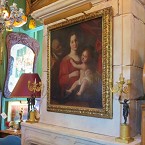



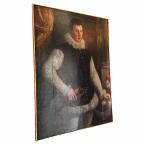





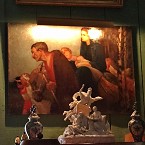
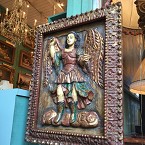
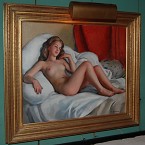













Height 28 inches
Width 24 inches
After his training in Amsterdam with François Boitard and
Bernard Picart, Jacques Aved started working in Paris for Belle in 1721. He later
entered at the Royal Academy of Painting and Sculpture Académie royale de
peinture et de sculpture in 1731 and he was appointed councilor after
graduating in 1734 and in 1759, he took part in his last salon. In 1753 he
became a member of the Confrerie Pictura
As an art dealer and collector, he owned one of the most
important collections with works by Italian French and especially Dutch artists
. This collection was sold at auction in 1766 . Carle Van Loo , François
Boucher , Dumont le Romain and Chardin were some of his pupils.
This incredible Artwork painting would be beautiful addition
to collectors or to decorate a law office a library , Hallway , Living room a
man's room or as a great elegant gift idea for an office space and house
warming . Antique dealer West Hollywood Melrose Ave La Cienega Blvd . On top of
a dresser a semainier a secretaire or in the background of your desk , this
outstanding painting with the hand carved wood gilt frame will be the touch of
old world adding the charm history and elegance to your decore .
This beautiful portrait of a gentleman is very versatile and
can go with any design, rustic farm , elegant space , formal setting , modern
or old world European charm . overall good shape, recanvassing so many of the
wonderful Art and with a Chateau inventory number that is still on the back
with number 16935 tag

18th C. School Jean Baptiste Greuze Peasant Child in a white
bonnet antiques LA . This exceptional painting of a peasant child in a white
Bonnet is a fine example of the style of Jean Baptiste Greuze, a very well
known and respected French painter of the 18th century.
Although unsigned, this work can be dated to the Greuze
period and contains many of the elements which the artist is known for. The
painting, if not by the hand of Greuze, is mot definitely by one of his close
students. Framed in nicely gilt and decorated wood frame. Documents from the
Metropolitan Museum of Art New York.
The picture of a young peasant is usually referred to as an
allegory of "Innocence," traditionally been equated with a sense of
innocence, gentleness, patience and humility. With such iconography in the
present picture, Greuze thus injects the female sitter with the same
characteristics. The depiction of young women tenderly and calmly sitting,
insinuating their ability to show tender emotion, relates to the 18th century
cult of sensibilité developed by Rousseau and his circle. Greuze's subject thus
appears infused with the subtle combination of sexual innocence and emotional
depth. Same applied to his circle.
This type of subject, employing young girls in various
emotional states, reached its peak in Greuze's career during the 1780s, thus
his circle as well.
Jean Baptiste Greuze was born at Tournus on Aug. 21, 1725.
His early life is undocumented, but he studied painting in Lyons and appeared
in Paris around 1750. He entered the Royal Academy as a student and worked with
Charles Joseph Natoire, a prominent decorative painter. During the 1760's Greuze
achieved a significant reputation with his sentimental paintings of peasants or
lower-class people seen in humble surroundings and in the midst of theatrically
emotional family situations; examples are The Village Bride (1761), The
Father's Curse (1765), and The Prodigal Son (1765).
In 1769 Greuze was admitted to the academy as a genre
painter. Ambitious to become a member of the academy as a history painter,
which was a higher rank, he was so angered by his admission as only a genre
painter that he refused to show his paintings at the academy's exhibitions (the
Salons). However, by that time he was already famous and could afford to ignore
the Salons.
The rising importance of the middle class, and of
middle-class morality, also played a part in the success of Greuze's cottage
genre. His work seemed to preach the homely virtues of the simple life, a
"return to nature," and the honesty of unaffected emotion. The
blatant melodrama of his preaching was not found offensive, and visitors to the
Salons wept in front of his paintings. The intellectuals of the day were
generally opposed to the rococo as a decadent style; rather paradoxically,
Greuze's most influential champion was Denis Diderot, one of the leading
philosophers of the Enlightenment, who hailed Greuze as "the painter of
virtue, the rescuer of corrupted morality." The fashion for simplicity and
the "natural man" penetrated the highest circles, and engravings of
Greuze's work were popular with all classes of society.
In terms of style, Greuze has been linked to neoclassicism.
The complexity of his compositions, however, and his interest in surface
textures place him within the general stylistic pattern of his period. In his
sensual paintings of girls (such as The Morning Prayer and The Milkmaid), with
their veiled eroticism, pale colors, and soft tonality, his connection with the
rococo is most evident. Some of Greuze's best work is to be seen in his portraits
(for example, Étienne Jeaurat), which are often sensitive and direct. Greuze
survived the French Revolution but his fame did not. He died in Paris on March
21, 1805, in poverty and obscurity.

A
Beautiful 18th Century Italian School
“The
Holy Family” painting.
Oil
on Canvas With Original Frame
Height: 40"
Width: 34"
Black Chalk on blue paper 17 ½” X 12” Framed 25” height, and 22” width. almost 3” thick
Note on the back: This drawing is in the manner of Pietro De
Pietri (1663-1716). See “Roman Drawings At Windsor Castle” Page 08-FIG.68. It
is Possible That Parry Studied The Pietri Drawing At Windsor, & was
Influenced By it. Joseph Parry
(1756–1826) was a British painter and engraver. He was popularly known by his
contemporaries as Old Parry to distinguish him from his sons James Parry (1795
– 1877) was a British painter and engraver and David Henry Parry, also artists.
Parry had a significant role in the development of
Manchester as a center of the arts due to both his mentorship of younger
artists and his direct influence on their artistic styles, and he is often
referred to as "the Father of Art in Manchester" (or variations
thereon) by both his contemporaries and later historians
By the 1820s, Manchester's art market had matured enough
that dealers were bringing significant works from London and abroad to sell,
and a generation of Manchester-based artists had emerged who felt that the city
needed its own counterpart to London's Royal Academy and the Liverpool Academy
of Art which could arrange regular exhibitions of new works as well as offer
financial and fraternal support to artists in need. Parry's two youngest
sons—James Parry and David Henry Parry—were both instrumental in the foundation
of what would become the Royal Manchester Institution as part of the initial
founding committee; the nickname "Old Parry" first appears around
this time in response to his sons' emergence as artists in their own right, and
the description of Parry as the "father of art" in the city is likely
intended semi-literally.
The Institution would go on to hold Manchester's first
non-commercial exhibition of paintings in 1827, featuring works from all three
Parrys, and their works would continue to be included in future exhibitions in
Manchester well into the 19th century. This includes the selection of several
works by Parry for the Peel Park Local Art Exhibition of 1857; he was described
in the visitor's guide as "the father of the Lancashire school of
art."
Museums which today hold pieces by Parry in their
collections include the Manchester Art Gallery, the British Museum, the
Merseyside Maritime Museum, the Whitworth, the Lady Lever Art Gallery, the
Salford Museum & Art Gallery, and the Shipley Art Gallery.
Though a native of Liverpool, his most significant legacy
was as "the Father of Art in Manchester," a title he was given by his
contemporaries for his influence on the city's early artistic community.
The subject of a very handsome bearded man with
extraordinary attention to detail. A Nicely executed Artwork with original old
frame of the same period of the 18th into 19th Century and
protected by glass. The Hand made Frame
is of hand carved wood and gesso , extremely detailed and preserved as
possible, but with signs of the centuries apparent, from losses to cracks as
seen in detailed pictures and video. considering the decades and elements.
it's a stunning piece to add to your special collection,
charming in any room of your home. very decorative and versatile, it can go in
a bedroom a living room , office , entry
or simply mounted as a focal point on top of a console or on a layered wall .
The frame is beautiful with some cracks and losses as seen in the pictures,
overall good condition. Antique Dealer West Hollywood CA Melrose Ave La Cienega
Blvd. This piece of art is timeless. Very versatile it can be in a traditional
décor as well as a farm, a winery , a modern house.
A great gift idea for a house warming, or to add to your
collection of unique beautiful Artwork.
Height 45 inches and Width 33 inches
This incredible Artwork painting would be beautiful addition
to collectors or to decorate a law office a library , Hallway , Living room a
man's room or as a great elegant gift idea for an office space and house
warming . Antique dealer West Hollywood Melrose Ave La Cienega Blvd . On top of
a dresser a semainier a secretaire or in the background of your desk , this
outstanding painting with the hand carved wood gilt frame will be the touch of
old world adding the charm history and elegance to your decore .
This beautiful portrait of a gentleman is very versatile and
can go with any design, rustic farm , elegant space , formal setting , modern
or old world European charm . overall good shape, recanvassing so many of the
wonderful Art
In the prime of his career, Allori headed one of the
"two most important workshops in Florence in the second half of the 16th
century" (the other being headed by Santi di Tito). He served as First
Consul of the Accademia del Disegno in 1573, and was made head of the Arazzeria
Medicea, Florence's state-owned tapestry workshop, in 1581. Allori also worked,
under the guidance of Giorgio Vasari, among the team of artists who decorated
the Studiolo of Francesco I. He contributed two painted panels, depicting a
Banquet of Cleopatra and a landscape with figures diving for pearls.
The cold and polished appearance of his painted figures
makes them resemble statues as much as living beings. The art historian Simona
Lecchini Giovannoni is more positive, remarking that Allori lends life and
immediacy to his paintings through his minute and realistic depictions of
vegetal motifs (especially flowers), household articles, and textiles of all
kinds; the "grandiose, introverted figures" are thus enabled to
"approach the spectator, not with dialogue and sentiment, but through the
tangible evidence of objects and details"
Among his collaborators was Giovanni Maria Butteri and his
main pupil was Giovanni Bizzelli. Cristofano dell'Altissimo Cesare Dandini Aurelio Lomi John Mosnier,
Alessandro Pieroni, Giovanni Battista Vanni, and Monanni also were his pupils.
He was the father of the painter Cristofano Allori (1577–1621).
In some ways, Allori is the last of the line of prominent
Florentine painters, of generally undiluted Tuscan artistic heritage: Andrea
del Sarto worked with Fra Bartolomeo (as well as Leonardo da Vinci), Pontormo
briefly worked under Andrea, and trained Bronzino, who trained Allori.
Subsequent generations in the city would be strongly influenced by the tide of
Baroque styles pre-eminent in other parts of Italy.
Height 45 inches and Width 33 inches


Framed important very Large Artwork in the Manner of Sir John Hoppner
SOLD



Portrait of a Lady American painter wall mount Art
Decorative painting framed LA , Portrait of Irene Dobson , 1914 Robert Knight
Ryland (American, 1873–1951). At the beginning of World war I , this painting
piece of wall art was signed on the canvas 1914 , with a carved giltwood simple
frame . pure elegance that goes with modern and traditional design alike . on
the frame someone carved on it in 1948 , right after the end of world war II . Ryland
American painter also worked for the Tiffany Studios . his painting “ Morning
with Snow ” 25 X 20 inches Sold $12,500 in 2019
Biography Robert Ryland A muralist, painter and illustrator,
Robert Ryland was known for his work as a New York World's fair artist,
1939-1940. Under the aegis of the NYWF, some of his paintings were given to
several New York museums including the Strong Museum in Rochester. Ryland also worked for the Tiffany Studios. “Morning with
Snow” 25 X 20 inches Sold $12,500 in 2019
Ryland was born in Grenada, Mississippi and lived in
Brooklyn and in Russellville, Kentucky. He studied at Bethel College in
Kentucky, the National Academy of Design and the Art Students League in New
York and the American Academy in Rome. As an illustrator, he contributed to
McCall's magazine, Delineator, and Everybody's magazine in 1922, 1923. Antique
dealer Los Angeles CA . This beautiful framed work is very decorative oil on
canvas.

A very sweet
and romantic depiction of her facial features . Pastel on Paper and laid in
oval board and framed in fabric inside a delicately carved wood painting frame.
Gallery Los Angeles Antiques West Hollywood la Cienega Blvd Melrose Ave . This charming tableau is very
decorative and it will add a touch or charm and warmth to any wall or corner in
your home . on top of a chest of drawers in a bathroom , entry , living . a splash
of history and color . the frame is hand carved wood and gilt with red fabric ,
hand crafted . The perfect gift idea for the holiday season , to place on a
side wall with a small light on top of a console , in a library or living room
. losses cracks fading over the centuries . A lot of charm and warmth . very
versatile in interior design ,



Height: 13 3/4" Width: 8 3/4" Depth: 1 1/2"
Pair of Silhouettes portrays the 19th century Lady and Gentleman With his Hat . This pair has been well taken care of and has minor wear consistent with the age . Wall art Silhouette of a Lady and a Gentleman framed in possible hand carved pine wood or fruitwood Frame . Charming elegant profile depicts high status man at ease with himself ensured his place in hierarchy looking sharp and same goes for the Lady holding what appears to be a document . The subjects are dapperly dressed with his top hat in his hand , trimmed haircut , leather boots and the lady with a nice Hairdo and an elaborate dress . An original continental French or British silhouette in a period fruitwood light color frames and are beveled. Antique dealer Los Angeles West Hollywood La Cienega Melrose Ave . The watercolor and paper cut silhouettes were largely painted and cut by aristocratic families during the English Regency and Georgian periods The black watercolor outline shows highlighted details of his hair , shoulder cape , coat buttons , and the flair of his trousers and her dress . Multiple hue and tone silhouette popular in the 18th and 19th century cut of a painted profile portrait done in black white Silhouette outline sharp shadow of the subject . This beautiful pair of wall mount Art on top of a console will add instant elegance . In a modern interior design or an old world charm traditional , decorative object for interior decoration design , A perfect gift during the holiday season , or special house warming present . It will be a great addition to your special collection in a library as part of the bibelot . in a bathroom , library , entryway , living room , bedroom . We have more more silhouettes 19th Century to create a gallery wall in a simple way to bring style and personality to any room and fits with Modern Art

Height: 19" Width:
14" Depth: 1 1/2"
This Silhouette portrays the 19th century gentleman With his
pointy cane . This item has been well taken care of and has minor wear
consistent with its age . Wall art Silhouette of an older Gentleman framed in a
Thuya Burl or possible bird's-eye maple . Charming elegant profile depicts an
older high status man at ease with himself ensured his place in hierarchy looking
sharp . The subject is a dapperly dressed gentleman with his top hat , trimmed
haircut , leather boots and cane . An original continental French or British
silhouette in a period Maplewood or Thuya rare burl frame and is beveled with
an inner frame What appears in a pale gold Color creating depth effect . Antique
dealer Los Angeles West Hollywood La Cienega Melrose Ave . The watercolor and
paper silhouettes were largely painted by aristocratic families during the English
Regency and Georgian periods The black watercolor outline shows highlighted
details of his gray hair , shoulder cape , coat buttons , and the flair of his
trousers and cane in gold color ink . Multiple hue and tone silhouette popular in
the 18th and 19th century cut of a painted profile portrait done in
black white Silhouette outline sharp shadow of the subject . This beautiful
wall mount Art on top of a console will add instant elegance . In a modern
interior design or an old world charm traditional , decorative object for
interior decoration design , A perfect gift during the holiday season , or
special house warming present . It will be a great addition to your special
collection in a library as part of the bibelot . in a bathroom , library , entryway
, living room , bedroom . We have more more silhouettes 19th Century
to create a gallery wall in a simple way to bring style and personality to any
room and fits with Modern Art .


























